 Fishing Report October 21 - Walleyes Still Active; Winnibigoshish, Cutfoot Sioux, Leech Lake Fishing Report October 21 - Walleyes Still Active; Winnibigoshish, Cutfoot Sioux, Leech Lake
Another glorious day of fall weather left me wishing that it hadn't been the last one. That's especially true considering that the fishing this week has been equally awesome! With more mild weather on the horizon, it's hard to imagine why anybody would want to spend their time inside when they could be out on the lake in pursuit of action, table fare, or maybe even Mr. Big! Even if my next trip isn't an "Oh-Fish-All" work day, I definitely see more fishing in my future, maybe even today once I wrap up this report and catch up on a few chores.
The story about Tuesday's fishing trip isn't a lot different than what you been reading over the past couple of weeks, but there is this one slight departure and it's about water temperatures.
At 50.5 degrees F, the Surface Water Temperature on Lake Winnie has chilled enough to force fish into late fall feeding patterns. During this period, Walleyes will continue to feed and strike, but getting in on good action means that your timing is critical. On Tuesday, we saw examples of both "Good Timing" and "Bad Timing".
In shallow water, on the north side of Winnie, a strong east wind stirred up whitecaps and activated an excellent period of Walleye action. The fish struck our jigs and minnows aggressively and it was easy fishing until the breeze gave way to calm. The difference was like night and day, even before the surface was completely free of turbulence, the fish retreated from the shallow water and held tight in deeper weeds. At this point, they become inactive and we were forced to move into fresh territory where there were green Cabbage Weeds growing deeper, in 12 to 14 feet of water.
Later, the wind picked up again and when it did, the fishing action perked up again; soon there was a good action bite, like the one we enjoyed earlier.
We had the same experience early in the day, before we left Cutfoot. Fishing at our first couple of stops was good, the wind had provided good drifting speed, there was a chop on the surface and the fish were active. A calming trend forced that early bite to collapse too.
Similar reports came from fishermen who rushed up for a fishing trip at Leech Lake after hearing glowing reports from friends. In their words; "Those guys were here last Friday and Saturday and caught boat loads of fish on Leech Lake, good fish".
The problem was that these guys showed up just in time for the calm weather on Monday. They fished hard on the mirror smooth water and returned to camp disappointed. I hope that they did better on Tuesday; I probably won't ever know but knowing about their experience, make me confident about this advice that I'm offering.
If you're planning your fishing trip for the upcoming weekend, do your best to wind up in the right place at the right time. If breezy conditions are forecast, then Walleye fishing during the daytime is likely to be good. But if there's a period of calm weather in your local forecast, prepare to spend the daytime in pursuit of Panfish which are now primarily located in deep water. Save your time to fish for Walleyes until the evening, when they will be more active. |
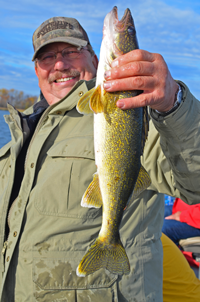
It was a good day to be Roger, Walleyes love the way he works his wrist, not too fast, not too slow, just right! An 1/8 ounce Lindy Jig, a large fathead and a strong breeze produced good action.
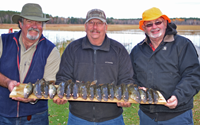
It was a good day to be Garry and Brian too. After releasing a dozen of more "slot-fish", we returned to shore with their bag limits of "keeper size" Walleye, along with some bonus Perch and Pike.
|
 Fishing Report October 20 - Warm Weather, Stable Temperatures Fishing Report October 20 - Warm Weather, Stable Temperatures
After spending most of my day off doing chores, catching up on paperwork and generally moping around, I couldn't help myself, I had to go for a boat ride.
I figured that as long as I needed to go out anyway, then I might as well check out Deer Lake. Knowing the Surface Water Temperature there, might help give us an idea about what some of the other deep water lakes in the Itasca area look like.
When I launched the boat, the surface water in the access bay was 52.5 degrees, but by the time I floated over the deep water, I observed readings ranging between 54 and 55 degrees. There wasn't much point in moving around the lake because the surface was calm as glass and there probably wasn't much variance from one end of the lake to the other.
I didn't spend very much time fishing, but I did have a brief opportunity to explore. Watching the Humminbird, I found out that most of the fish in the lakes western basin are still suspended over deep water. I located several small groups of fish suspended at about 20 feet, over water depths of 45 to 55 feet.
There was one deep water point where some fish were scattered along the break in 35 feet, I dropped a jig and minnow to them, but my offering was not well received.
Instead, I settled for the grand finale'; a fabulous sunset over the mirror smooth water. I guess that could be the last one I'll see on that lake for a while. But I'll probably see the sunset again this evening, this time over Winnie, Leech or maybe Cutfoot.
Usually, I'd be heading west to do some hunting at this time of the season. This year, circumstances are keeping me closer to home and as long as I'm here, I'm cleaning out the closets. For anybody who has an interest in the outdoors, you'll be noticing some interesting items going up for sale. I'll be posting them as time allows, check the report occasionally for links to find hunting, fishing and outdoor gear for sale.
|
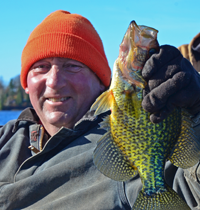
Deep water fall patterns continue to produce Crappie. Suspended over deep water, these fish were holding between 22 and 30 feet deep.
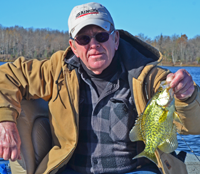
|

|
Lake Mille Lacs: Winter harvest cap set;
(10/19) ice fishing regulation decision by end of month
State and tribal biologists have reached agreement on how many pounds of walleye could be harvested by Mille Lacs Lake anglers over the winter season, according to the Minnesota Department of Natural Resources. The agreement paves the way for a decision later this month on the state’s ice fishing regulations.
At a meeting Oct. 15, DNR and tribal biologists agreed to set the winter harvest cap for state anglers at 5,000 pounds or less. The total walleye harvest last winter was 3,100 pounds. The DNR and the Chippewa bands were able to reach this decision because September fish assessment data show that pounds of spawning-age walleye and numbers of walleye from the 2013 year class were above established benchmarks.
|
“This decision allows anglers and businesses to look forward to some harvest opportunity during the upcoming winter angling season that begins Dec. 1,” said Don Pereira, DNR fisheries chief. “We’ll announce a final decision about the details of the ice fishing season by the last week of October, following an Oct. 21 meeting with the Mille Lacs Fisheries Advisory Committee.”
In preparation for that meeting, DNR biologists will evaluate the potential effects of various fishing regulation alternatives for discussion with the committee. Results of those analyses and input from the advisory committee will then be considered in making the final decision for this winter.
“We will monitor creel data every two weeks during the winter and will assess in January whether we need to adjust the state’s harvest level for the rest of the winter to stay under 5,000 pounds,” Pereira said. “At the January State and Tribal Fisheries Technical Committee meeting we will set the safe harvest level for the year, which will inform the open water fishing regulation to be set in late winter.”
Mille Lacs Lake background
Since 2008, not enough young walleye have been surviving to maturity and replenishing the Mille Lacs Lake population. As a result, Mille Lacs walleye numbers are currently at a 30-year low. In response, the state instituted more restrictive walleye regulations earlier this year in order to protect young walleyes so they could grow older.
The Mille Lacs 2015 walleye safe harvest level was deliberately reduced from 60,000 to 40,000 pounds so that more fish could potentially survive and spawn to improve the walleye population. Under the 2015 quota, state anglers could harvest up to 28,600 pounds of walleye, and the eight Chippewa bands with 1837 Treaty harvest rights could harvest up to 11,400 pounds of walleye.
On Aug. 3, the DNR closed the lake to walleye fishing after state anglers exceeded the quota of 28,600 pounds. Following the closure, the DNR announced that it had begun implementing several concrete steps aimed at improving the Mille Lacs Lake walleye population, while building a closer working relationship with the Mille Lacs community. Technical work is underway to determine if experimental fry stocking is feasible.
“Even after encouraging fall fisheries assessment data, there is still a need to protect spawning-sized walleye, as well as the young fish that we need to survive into adulthood, to allow the walleye population to continue to improve,” Pereira said.
For more about how the DNR has implemented steps aimed at improving the Mille Lacs Lake walleye population, and improving its working relationship with the community, can be found at
www.mndnr.gov/millelacslake under the “Building A Future” tab.
Lake Mille Lacs On A Roll
"There’s good news for fans of Minnesota’s Mille Lacs Lake this week on several fronts, according to local guiding ace and Lindy pro Mike Christensen.
“In the short term, yellow perch and smallmouth bass are biting right now—and we just found out there’s going to be an ice fishing season for walleyes,” he said." Read More About >> Lake Mille Lacs On A Roll |
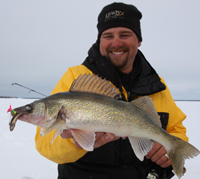 |
 Fishing Report October 19 - Cutfoot Walleyes Sitting In For Lake Winnie Whitecaps Fishing Report October 19 - Cutfoot Walleyes Sitting In For Lake Winnie Whitecaps
I was really anxious to get back on Winnie this Sunday to learn if Walleye and Perch action was still holding up. Unfortunately, strong southerly winds stirred up whitecaps large enough to force me to think small instead. Luckily, Walleyes in Cutfoot Sioux were more than willing to stand in for their big water cousins.
At the landing, Surface Water Temperatures had fallen to 53 degrees and that made me nervous. I had my fingers crossed, hoping that I hadn’t driven my crew to a lake that had already turned over and had nothing left to offer except for memories.
We soon discovered that either we were still on the right side of the thermocline, or else the wind was working for us as an asset. Either way, I caught a lucky break; the Walleye were cooperative and plentiful.
The most productive fishing depths varied between spots, but typically fell within the 10 to 16 foot range. On this particular trip, it appeared that slightly deeper water produced a higher percentage of “keeper size” Walleye and shallower water produced mainly “slot-fish”.
All we needed to catch Walleyes was a handful of 1/8 ounce Lindy Jigs and a scoop of minnows in the 3 to 4 inch size range. Rainbows, Shiners or big Fatheads all produced fish, the size was more important than the variety. I was tempted to experiment with other presentations, but under the circumstances it would have been sort of silly.
I think that unless there’s an alternative presentation that you love so much that it compels you to avoid jigging, it’s just makes too much sense to stick with the highly effective jig and minnow presentation.
For today, calmer seas and bright skies combined with a day off will undoubtedly force me to focus my efforts away from shallow water Walleye fishing. Turnover notwithstanding, clear water and calm seas has never produced the most desirable results, especially in the aftermath of a big blow.
So maybe I’ll pick on the Crappies today, maybe some Sunfish, who knows? I might not even go fishing at all. I can definitely promise you this though; I won’t be wasting this beautiful autumn day by sitting around the house. |
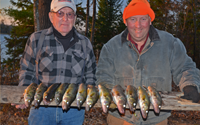
This windy Sunday, fishing slightly deeper water of 14 to 16 feet produced a higher percentage of “keeper size” Walleye for eating. For us, moving into shallower water produced more “slot-fish”.
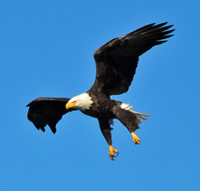
|
 Fishing Report October 18 - Leech Lake, Cutfoot Sioux, Lake Winnie Fishing Report October 18 - Leech Lake, Cutfoot Sioux, Lake Winnie
The weather couldn't have been much better for the MEA weekend, a popular "season ender" for many Minnesota families. Sunshine helped warm the waters of popular Walleye destinations and the breeze encouraged fish to remain active.
A text that I received on Saturday from my friend Bob Cass sums up the Winnie Walleye report fairly well, it says; "Jeff, FYI we have killed the walleye Thursday and Friday (on Winnibigoshish) in 8-10 feet (of water); 75 fish in three boats yesterday. Some great Jumbos too, better than I have seen in a long time."
Robby Ott, sent a text too, a short one that one says; "Fantastic Crappie fishing today, Walleye fishing tomorrow". Similar reports came in from Leech Lake, Cutfoot Sioux and Bowstring Lake.
For me, there are only a few more days remaining on the fishing schedule and then I'm gonna be forced to switch gears into "land-lover mode". I'm guessing that many of you have already put your boats away for the winter, but for the die-hards out there, we'll be doing our best to glean the glean-able and decipher the decipherable. |
|
 (10/18) Q&A I had a crappie question for you. From June up until early October, I've been doing well with the crappies with a 1/16 oz. Little Nipper and 1 inch Gulp minnow, but that bite has shut down in the last week. Do crappies switch from Gulp back to live minnows once the water gets cooler? I'm thinking I need to switch to live bait and slip bobbers and slow it down. This worked well in the spring. Any thoughts you have would be great!
(10/18) Q&A I had a crappie question for you. From June up until early October, I've been doing well with the crappies with a 1/16 oz. Little Nipper and 1 inch Gulp minnow, but that bite has shut down in the last week. Do crappies switch from Gulp back to live minnows once the water gets cooler? I'm thinking I need to switch to live bait and slip bobbers and slow it down. This worked well in the spring. Any thoughts you have would be great!
A) I have used the gulp minnows too, and these along with some of the other small gulp products, have accounted for a ton of crappies and sunfish as well. I wish that I could give you a scientific formula that explains why these baits work so well at times, but get the cold shoulder at others. More than likely, it's the relationship between the similarities of a lure to the forage that fish are feeding on at the moment that we're fishing for them.
In other words, I don't believe that the productivity of any bait can be determined entirely "by seasons". In fact, I've experienced times when these baits have apparently run their course, but then get hot again for a period of time. Whenever I am fishing with customers, I always prefer to be the odd man out in terms of bait. So while they fish with "tried and true" presentations, I do the experimenting with alternative lures and baits.
Over the past couple of autumn seasons, I've become increasingly convinced that the most reliable of all presentations for Panfish is an Ice Worm tipped with Wax Worms. The reason is that there a many times when schools of Crappies and Sunfish are located so close together that they almost appear to be mixed together. If we're using minnows, we may catch Crappies, but by and large, the Sunfish ignore them. Conversely, Crappies will typically strike the Wax Worms, even at times when they might not be their true preference.
What that means to me is that I can help provide my fishing customers with additional opportunity for action. Recently, I've really become a fan of the #6 Ice Worm. They are heavy, so you can easily feel them in deep water, but they're compact so they don't spook finicky fish. They are versatile too, you can tip it with a small minnow or a Wax Worm. But if you want to, you can use the artificial tails on them too; that makes them exceptionally efficient.
I would definitely keep the Little Nippers in your arsenal, but as long as the ice season is coming up anyway, add a few of the Ice Worms and a few Tungsten Toads into your mix too. I think that you'll be pleased with how well they round out your repertoire.
 (10/18) Q&A Steve Sykes Wrote
(10/18) Q&A Steve Sykes Wrote; I was wondering what kind of batteries you use for your trolling motors? I just finished the 3rd season on mine and I think they are starting to lose it, toward the end of the season I noticed they weren’t holding their charge very well. Fishing as much as you do how long to you expect yours to last? Also during the winter months do you leave your batteries in your boat to take them out and store them where it’s warmer?
A) Steve, when it comes to value, I don't think that you can beat the Everstart batteries from Walmart. They are manufactured by Johnson Controls, the same company that produces Die Hard, Interstate and other brand popular name batteries.
Their “group 29” size battery is slightly larger than a typical marine “group 27” size battery. But, if you have the extra space in your battery compartment, the group 29 is the ultimate value in mile opinion.
Walmart provides an over-the-counter two-year replacement warranty on that battery. Unless you plan some extreme service conditions and intend to run your boat every day of the open water season, it’s unlikely that you’d wear this one out.
Their group 27 size battery, the typical size of most deep cycle marine batteries and it’s the one I currently use. The group 27 size features a 1 year warranty and I have never worn one out early enough to take it in for replacement.
Typically, I get about 1-1/2 seasons out of each battery; that amounts to roughly 225 fishing trips providing that I take care of it over the winter.
For me, the best way to take store my batteries through winter is to remove it from the boat, bring it inside and store it in a dry warm place. In my case, this is in the basement on a short piece of 2 x 10 that I have set aside for that use.
If I had the boat parked inside a heated garage, then I would be comfortable disconnecting the cables and leaving the batteries installed in the boat over winter.
 Fishing Report October 14 - It's Unanimous; The "Eyes" Have It Fishing Report October 14 - It's Unanimous; The "Eyes" Have It
There are certain days when alone, neither Wall"Eyes" nor Crapp"Eyes" have enough get up and go to produce an action packed fishing day. On the other hand, there are those days when the combination of fishing for specks and whitetails in the same trip can be an "Eye" opening experience!
In the aftermath of Monday's explosive cold front, Walleye fishing for my crew and me was a blue collar job. As long as we kept moving, working and sniffing out fresh territory, we picked up fish. But except for one small spot, I could never find a school of fish large enough to provide steady entertainment.
At 54 degrees, the Surface Water Temperature was in my nerve racking zone, forcing me to question whether or not the lake was on the verge of turning over or if it already happened overnight. There weren't any convincing clues in the water, but maybe that's why the fish were sluggish.
Of course and air temperature drop of 40 degrees could chill the battle field too; maybe the fish were just too cold to get it in gear. Having an explanation really didn't matter; we worked at catching fish, picking 'em up steadily throughout the day.
By late afternoon I think that all of us were probably ready to go home, but all of us held back from speaking up. By now it was beautiful outside and I believe that all of us were thinking the same thing; we're not gonna get too many more days like this one.
It was definitely lucky that we lingered because on the way back to the landing, I decided to take one more stab at finding an elusive school of Crappies. I'd searched for them earlier in the day, but either they weren’t schooled up or else I did not cross paths with them the first time.
The truth is that I almost missed finding them this time too, but just as I was ready to throw in the towel, fish appeared on the screen and instead of the towel, I threw in my marker buoy instead.
Now I could tell you all about the depth of the fish and the jigs we were using and what kind of minnows we had on and if I do, you will read it and ask; “So What?”
That's because you've already read the details before; Walleyes in 12 feet, crappies in 30 feet, jig and minnow, ice worm and a wax worm … and so on.
The highlight of this fishing trip wasn't about practices and procedures, it was emotional.
My heart was racing because I watched my good friend Kevin, an otherwise calm and collected sort come totally unglued as the explosive action frazzled his nerves.
I'm not saying that I and Ole weren't giddy too, but Kevin's episode was special, he was lit up like a Christmas tree. It was his enthusiasm and appreciation of what happened at that moment that is gonna etch this experience into all of our hearts and minds forever.
All I can say is that I was Lucky; lucky to find those fish, lucky to have those boys with me and lucky that the lake has fish that see "Eye" to "Eye"!
|
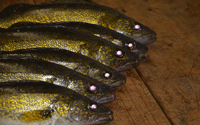
Sometimes it's the combination of fishing for both "whitetails" and "specks" in the same trip that makes it an "Eye" opening experience!

My heart raced as I watched Kevin, an otherwise calm and collected sort come totally unglued as the explosive action frazzled his nerves.
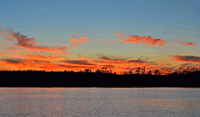
The lake knew what we needed and that's just what she gave us. Not too many fish, and not too few; just the right number. OH and this warm hug to wrap up our day.
|
 Fishing Report October 13 - Have You Wondered Why Odd Occurrences Occur In Autumn? Fishing Report October 13 - Have You Wondered Why Odd Occurrences Occur In Autumn?
It happens every single day during the fall, somebody leans over and asks; is that all fish that I see on your Humminbird? My answer is almost always the same, yes; they're fish, but not necessarily the kind of fish that we're looking for.
It could be anything from 1 inch long Sunfish to 8 inch long Walleyes to a gigantic swarm of Dogfish minnows; if it lives in the lake, it could be hanging out in open water during the fall. I usually add something like "when I see what I'm looking for, you will be the first to know".
That exchange is usually followed by this over-simplified explanation about why this always happens during the fall.
Just like the crops that you see being harvested or the autumn leaves changing color and then dropping from the trees, submerged plants come to the end of their life cycle during fall. Now that the waters are turning cold and the days are getting short, submerged plants begin to wither and die.
|
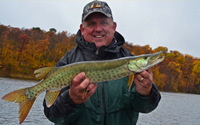 When autumn leaves turn gold and submerged weeds wither away, odd occurrences like this small Musky grabbing Kenin Scott's jig become routine. I wonder if this little one will remember us when we catch her again in 2025. When autumn leaves turn gold and submerged weeds wither away, odd occurrences like this small Musky grabbing Kenin Scott's jig become routine. I wonder if this little one will remember us when we catch her again in 2025.
|
They've done their jobs; they provided summer cover for all of the small fishes and added Oxygen to the water. They produced food too, insects and crustaceans that fed all of those hungry little critters. Without weeds, many of the small fish would never have lived long enough to see the colors of fall.
Everything comes to an end though and as they die off, the weeds that once provided a breath of fresh air, now produce deadly gases, the shallow water sanctuary becomes uninhabitable. Fish of all shapes and sizes begin moving toward open water, eventually gathering into large schools.
So whenever we begin noticing all of these fish in open water, somebody leans over and asks; is that all fish that I see on your Humminbird? But I digress.
Fast forward to a conversation a few days ago when one of my crew asked; "How come nobody ever catches a little Musky?" I said they do, but it usually doesn't happen until fall, when all of the small fish get forced out of the weeds, that's when they show up.
Like the one that popped out of the weeds to grab Kevin Scott's jig and minnow yesterday. It was beautiful, lively and looked really healthy. And it may well have been this fish's first encounter with any human being. If the weeds were still green and healthy, we probably would never have known it was living there.
This is how you can use the fish to help gauge the progress of the fall timeline. When odd occurrences begin to happen routinely, that means that we're approaching the beginning of the next cycle.
On Monday, there wasn’t much doubt that we were approaching the next cycle! If you think about it, whenever when the wind speed and the air temperature are the same, it’s uncomfortable. I doubt that they were actually equal, but the correlation is close enough. There weren't too many comfortable places to go for folks who wanted to be on the water.
The Surface Water Temperature on Cutfoot Sioux started at 58 degrees in the morning and slipped to 57 degrees by the end of our fishing day. I’m sure that it slipped some more overnight, but it’s unlikely that it dropped enough to force the lake to turn over. Winnie on the other hand was already teetering on the edge of the dreaded (for me) 55 degree mark. It’s trickier to predict what happened out there, especially while there’s frost on my crystal ball.
As far as the fishing was concerned, we did our best, hunkering down in the calmest places we could find, some of them produced fish, and some didn't. Sometimes I could see fish on the Humminbird, but we couldn't hold still enough to work our baits effectively enough to produce strikes. Sometimes I didn't see a darn thing on the screen, but we caught fish anyway. In other words, when we caught fish it was by either sheer determination or by Good Luck!
I'm less than up to speed about how things will work today, but I’m hopeful that as the winds settled, the fish realized that they are supposed to be stocking up the pantry before winter.
 Fishing Report October 12 - A Warm Ending To The Beginning Fishing Report October 12 - A Warm Ending To The Beginning
According to my friend Erling Hommedahl, This day was handpicked for him, his wife Karen and me. It was our gift, a reward to make up for the day we spent on the lake last fall. The day when the winds blew in at 25 MPH, the air temperature tickled the 30 degree mark and snow fell on the water while we fished.
The more I think of it, the more I believe he was right. It was a sunny, 80 degree day; the wind was calm and the fish bit anyway; who could argue with Erling's wisdom? No matter how you look at it, this was one heck of a nice gift and I am thankful for sharing it with my friends!
Last week you read my report about Walleye fishermen, patience and "hot bites". I said that if you can catch Walleyes under tough conditions (for Walleye fishing), then YOU KNOW that it will be awesome when the conditions are ideal.
Okay, so anybody who's got any experience as a Walleye fisherman knows that Sunday probably didn't turn out to be a "barn burner" fishing day. On the other hand, taking home 10 keeper Walleyes, a dozen Jumbo Perch and a limit of Northern Pike doesn't sound bad on a day when the bottle of sunscreen is more important than the color of the jigs we were using.
As you'd expect, the Surface Water Temperatures rose throughout the day, touching the 59 degree mark before we left the water. The sunshine forced a really heavy Algae bloom to develop and the I think that the shade on the surface water helped account for the fish’s' activity.
The warm surface water won't stay that way very long, but it probably did forestall the turnover for a few more days; that depends on how severe this imncoming weather system turns out to be.
|
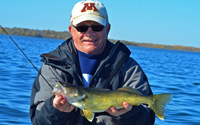 The day was handpicked for Erling and Karen Hommedahl. Warm, sunny and the fish cooperated. The day was handpicked for Erling and Karen Hommedahl. Warm, sunny and the fish cooperated.

On Lake Winnibigoshish fantastic scenery, great weather and good fishing; a warm week ending.
|
If you read the recent reports, you can get all of the information you'll need, but to sum it all up. We fished in water depths of 10 to 14 feet; we used unpainted 1/8 ounce jig heads and tipped them with minnows. You should be using larger than average size minnows, 3-4 inches long and Rainbows, Fatheads or Shiners will all work.
For today, the beginning of the hard-core, fall fishing season is upon us. Strong, gusty winds and Grey skies should encourage the Walleyes, but the wintery winds may force me into a protected corner of Lake Whoknowswhereweare. No matter where we wind up, You Know that You'll be the first to Know!
 Fishing Report October 11 - Warm Breezes Blow In Big Fall Fishing Crowds Fishing Report October 11 - Warm Breezes Blow In Big Fall Fishing Crowds
It was a busy day on the lakes this Saturday, the bait shop was busy and the ramps were full. Anglers who found their way on to the water were treated to warmth, sunshine, lots of fall color and a "Walleye Chop" on steroids.
For me, the breezy conditions weren't a factor; I didn't need to fight the big waves because our goal was to catch Panfish anyway. For that, I was grateful, and I hope that the blustery conditions didn't get the best of you.
For Walleye fishermen, especially those with rigs set up for big water, the winds played into their hands. Combined with Surface Water Temperatures hanging on in the 56 to 58 degree range, the current produced by the waves encouraged good Walleye action.
Leech Lake hasn't been getting its fair share of attention this fall, but over the past few days it's been kicking out good numbers of Walleye and some nice Perch too.
Portage Bay has been disappointing for most fishermen, but there are a few isolated schools of fish along the weedline.
Typical of Leech Lake during autumn, rocky points that are exposed to strong winds have encouraged a good shallow water Walleye bite. Many of the popular rock spots on the main lake and in Sucker Bay are producing good action. As long as there are waves crashing in, rocky points have potential.
Lake Winnibigoshish and Cutfoot Sioux were productive too, but the strong south wind didn't help everybody. The popular fishing spots along the north shore were difficult to manage, so many toughed it out in Cutfoot instead.
Panfish got the attention of many anglers and from what we could see, there were a fair number of Crappie and Sunfish being captured on Little Cutfoot. The crowd was large, but polite and most folks seemed to be more interested in enjoying the nice day rather than arguing over fishing territory.
Bluegills were easier for us to fool than were Crappies, so that's what we spent most of our time fishing for. We found the lion's share of them in water depths of 11 to 13 feet, on steep breaklines that were close to shore. I tried roaming the open water too, but I didn't like what I saw out there, there were only some small, widely scattered schools of fish.
When it came time to get serious about Crappies, we moved back out to Big Cutfoot. The wind was strong and it made feeling the strikes tricky, but we did manage to find enough active fish to satisfy us.
|

Anglers who found their way on to the water this Saturday were treated to warmth, sunshine and lots of fall color.
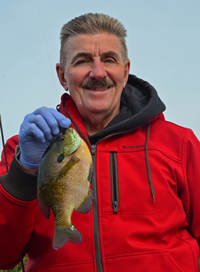
We found the lion's share of Bluegills in water depths of 11 to 13 feet, on steep breaklines that were close to shore. A #6 Lindy Ice Worm tipped with Waxies works like a charm.
|
The paper mouths were holding deeper than before, now in 30 to 32 feet of water. That meant that catching and releasing fish was not an option, we bagged the first 20 fish we caught and then left the rest of them alone. Sizes varied between 10 and 12 inches, all of them acceptable for eating.
Crappies responded well to an 1/8 ounce Lindy Jig tipped with a small fathead and in the strong wind, that was all I needed to know; we didn't experiment with other baits.
For today, Walleyes are on my agenda and there's another strong wind predicted and so that means ... well I'm gonna get wet. Luckily, it's gonna feel just like summer, the cold splashes might even feel good on the back of my sunburned neck!
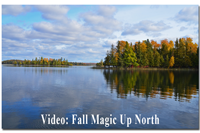 |
Sometimes folks tease me about missing a day on the fishing report because they think it means that I took a day off. But for anybody who watches close, You Know that somehow, you're gonna wind up KNOWING whatever I was up to during my absentee session.
Thank you for bearing with me, and for allowing my occasional clues about "Special Projects" that I'm working on. Today, I've got one to share and I hope you'll share it with your friends too. View Video >> Fall Magic Up North |
 Q&A What Is That Cloud On The Screen? Q&A What Is That Cloud On The Screen?
In an email, Jeff Anderes wrote; "I saw something on the lake that I’d like your opinion on. After we fished for Crappies in the morning and as we worked our way back to the boat launch, we noticed that the whole screen was filled with major activity up to about 5 from the bottom. The area where we searched was near the shoreline in water depths of 18- 26 feet. We had fished the same area earlier in the morning and there was no evidence of this phenomenon. Is it plankton coming up as the water warmed?
A) Jeff, there could be more than one way to answer this question. But more than likely, you answered your own question when you mentioned Plankton.
Even without seeing the image of your graph, it sounds to me like you're describing what I refer to as “The Death Cloud”. A gigantic Hodge podge of living creatures that are so small, we could look at a glass of water filled with thousands of them and never even know that they were in it. These gigantic clouds of Plankton do clutter the screens of graphs and flashers; once you’ve seen it, it’s usually a signal that it’s time to go home.
Like the game fish we pursue, these tiny organisms have feeding cycles too. When they become active, they rise up above the bottom and at times, fill up the entire screen of today’s sensitive electronics.
Typically, you’d see this type of image during late afternoon, as evening approaches, in fact I wrote about it last winter in the Ice Fishing Report February 4, 2015. But I can’t think of any reason that Plankton wouldn’t occasionally become active during the daytime too.
The reason I call it the death cloud is because when these huge clouds of Plankton appear, it usually means that gamefish are either not present, or are at least not actively feeing. For me, fishing in an area where I see the “Death Cloud” is usually a complete waste of time. Whenever there are predators feeding in the area, these clouds of microscopic food disperse and your screen would be free of this clutter.
If the image on your screen had appeared higher in the water column near the surface, then I’d guess that you’d been viewing tiny young of the year baitfish of all species.
These small fishes are forced to leave their weedy shallow water sanctuaries when frosty temperatures force the weeds to die off. For a time, the shallow weeds become uninhabitable. When that happens, everything from ¾ inch long Perch to 8 inch Northern Pike are forced out into open water. Their only defense against being eaten is to suspend higher in the water column, making it more difficult for predators to track them down. |
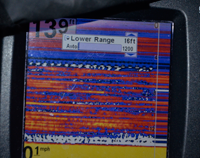
The appearance of the “Death Cloud” is usually a signal that fishing in the area would be a complete waste of time.

Whenever there are predators feeding in the area, these clouds of microscopic food disperse and your screen would be free of this clutter.
|
 Fishing Report October 9 - Walleye Fishing Like The Good Old Days or ... A Word To The Wise? Fishing Report October 9 - Walleye Fishing Like The Good Old Days or ... A Word To The Wise?
Was that really great Walleye fishing, or was it "the tap on the shoulder" letting me know what to expect; the turnover is coming soon?
That was the question echoing through my head on Thursday after we experienced a particularly stellar episode of shallow water Walleye fishing on Winnibigoshish. Sure, the conditions were perfect, Grey skies along with a brisk wind that churned the water over a shallow rock bar. But catching 16 keepers and another dozen "slot-fish" in a couple of hours, is that normal? No, that's too good to be true, but it is what happened.
Pinning down the exact time of the fall turnover is a slippery subject. That's not just because there are so many variables, but also because not every lake has a turnover and the ones that do, don't all undergo the transformation in the same way. That's why it took me about 25 years of head scratching to actually form an opinion about how and when the turnover occurs.
As a result of all that deep thought, I’ve concluded that there is one thing that I KNOW. Just before a lake turns over, there is always a brief period of time when you feel like you own the keys to the magic kingdom; there's a day, maybe two when you just can't do anything wrong. I think that yesterday might have been one of those days.
We found Surface Water Temperatures on Winnie hovering between 55 and 56 degrees. Evidence of fish along deep weed edges was much less apparent than it was a few days ago. There were still baitfish, and some Walleye and a few Pike too, but they were definitely fewer and farther between.
I knew that the fish had moved, but which way did they go? |
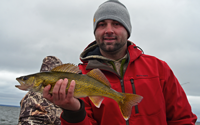
Chris Nickell's 1/8 ounce Lindy Jig tipped with a minnow barely made it to the bottom before he proclaimed; "Fish On!"
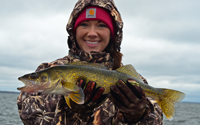
It wasn't long before before the shallow rock hump sent Walleye and Perch popping out of the water like popcorn.
|
A hunch that we needed to take advantage of the brisk wind turned lucky when I stopped on a shallow rock hump in 6 feet of water.
Chris' 1/8 ounce Lindy Jig tipped with a minnow barely made it to the bottom before he proclaimed; "Fish On!" Then Krissy had one hooked, then me, then Rick and it wasn't long before the fish reminded me of popcorn popping, Walleye and Perch were popping out of the water up all around me, it was chaotic.
Nothing lasts forever and after those couple of hours, the action faded, but it was fun while it lasted. I already know better than to expect this to happen again, especially when the weather changes and I'm not thumping my own chest either, I AM the first to admit; I got Lucky!
I’m hoping that for you, the story helps illustrate the larger point; that we should be prepared for a change. Fish that you've had dialed in for the past few weeks might just be disappearing soon. It doesn't mean that the bite is over; it just means that you'll need to find 'em again, dial in some new patterns.
I'll be taking special care to report on the turnover from my perspective, but while you're waiting for new news, re-visiting some of my reports from the past few seasons could be helpful.
I'll do my best to make finding them easier, I'll get some links together that will lead you to more information, but right now, clicking this link to October 2013 and scrolling down to October 5th will get you started.
 Fishing Report October 8 - Fall Walleye Migrations Fishing Report October 8 - Fall Walleye Migrations
For me, Wednesday was filled with surprises; some pleasant, some not so much. As you may have come to expect, Cub Reporter Staff #003, IHBFBB never dwells on the unpleasant, so today's report focuses on some of yesterday's more pleasant moments.
For openers, my morning began; there was a fantastic display of Northern Lights showing in my back yard. A few hours later, the frosty overnight temperatures served to produce a sunrise that was full of steamy, pastel colors and delightful rays of light glowing through the fog.
A few hours later, it was definitely delightful to arrive at Cutfoot Sioux and find out that Surface Water Temperatures held steady at 60 degrees against the sub-freezing night. Later we'd discover that the SWT on Winnibigoshish was stable too, holding steady at 57 degrees.
There was another surprise, one of the best ones and it happened before I'd made that run to the big lake. We were really on a mission to catch Walleyes, but I knew that my fishing partner would love to take home some Crappies too. I didn't want to make a career out of finding them, but I did want to check out a few spots just in case I could find a fast school of easy biters.
Enter my friend Jeff Anderes, a great fisherman and the quintessential gentlemen. Jeff noticed that I was on the prowl, thought he recognized me and asked; "is that you Jeffrey?" (I don't know why everybody calls me that, but they do) and when I said yes, he said; "come on in". Long story short, Jeff was already on a good school of Crappies, invited me in and after a brief period of figuring my way over the school, we pulled out just enough of them to satisfy John and we were out of there. Thank you again Jeff, I really appreciated that!!
OH, and by the way, if you would ever need his services, I’m sure that you would love having Realtor; Jeff Anderes help you find your next home.
The next pleasant surprise came along as we headed toward the big lake from Cutfoot. The fall colors were as good as they get and my lucky camera captured a few nice images that will help us all remember why we look forward to the fall fishing season.
Our next pleasant surprise came when despite the clear water, calm seas and sunny sky, Lake Winnie's Walleyes were cooperative. A re-run of the experience that I had with Mr. C last weekend, the fish were not jumping into the boat, but they were aggressive enough to produce steady, albeit slow action. By the time we were finished, we had a half dozen "Keeper Walleyes" and we'd released a half dozen more. This time Northern Pike were present, but there were fewer of them than I've been seeing recently.
The simple presentation, a
1/8 ounce Lindy Jig tipped with nice size minnows will do the trick. But I've noticed that has been "a trick" to producing strikes consistently with a jig and minnow. An aggressive snap or hop of the jig is required to get the attention of these Walleyes. If the jig isn't being jigged enough, the Walleyes yawn and watch it swim by.
So if you're trying to replicate my experience, then please keep this in mind; if you're not jigging enough, you could disappoint yourself. If you see me out there, stop and chat so I can try to give you a pointer.
There were more nice surprises later in the day too and I'll do my best to tell you all about them, but first I gotta run, there's fishing in my future and I'm up against the clock. I'll be seeing you out on the lake! |
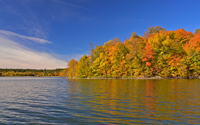
The fall colors were as good as they get on Cutfoot Sioux this Wednesday. Seeley Point was on fire!
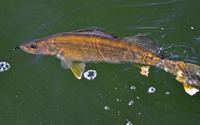
Despite the clear water, calm seas and sunny sky, Lake Winnie's Walleyes were cooperative. 1/8 ounce Lindy Jig tipped with nice size minnows will do the trick.
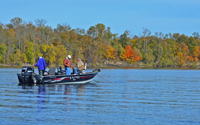
On Lake Winnie, crowds are light, the scenery is gorgeous and the fish are biting; what are ya waitning for?
|
 Fishing Report October 6 - The Clock Is Ticking, Countdown To Fall Turnover Fishing Report October 6 - The Clock Is Ticking, Countdown To Fall Turnover
On Lake Winnibigoshish, Surface Water Temperatures moved another notch downward on Monday. Now pegged at 57 degrees, we're entering into the time of season that you could describe as the nerve racking part of my job. This is the time that I start worrying which one of these days will be the one day that it's too late, the day that the "hot bite" is over for the season. Figuring it out is tricky because the exact timing is slippery, it's hard to know for sure unless youshow up on the lake to take your medicine, to learn it the hard way.
You could call me a specialist on learning my lessons the hard way; I’ve shown up in a lot of places when the timing was wrong. Luckily, the timing on Winnie is still good, even if our days are numbered.
On Monday, conditions for Walleye fishing were good, the Grey skies and choppy surface
had the fish moving. In fact everything was moving, Perch were present in numbers larger than I've seen this fall and the Pike, they were still there too.
Fishing the weeds was still the key, water depths of 12 to 14 feet were good, jig and minnow combinations continued to perform as they have been all week long.
The fish were a bit "flighty" on Monday, it was easy to find them and easy to catch the first few fish at almost every stop. Going back for a second pass turned out to be a waste of time though, we almost always caught the lion’s share of our fish, the most active ones on our first drift.
Even having that little problem, the fish covered such a broad range of territory that there was little reason for concern. All we had to do was keep making short moves, watching the screen of my Humminbird and stopping whenever we spotted a school of fish. The pattern was solid, we were getting bit steadily and sorting through the "slot-fish" in order to gather some keepers. The fish were on the move, we were on the move and our prospects were looking good.
Our problem was that there was one too many things moving, a case of Interrupit vomitus made fishing on the big lake a little too interesting. Even though we did our best to overcome the distractions brought on by the rare outbreak, we eventually succumbed to our feelings of compassion and guilt for the poor lad with the affliction. The next stop for us was a nice walk along the shore, followed next by a visit to the "Crappie Hole".
Today, the Crappie hole covered more territory than usual. I was able to find small packs of fish, stop on them and catch 8 to 10 fish, but like the Walleyes, they were flighty too. Before it was over, I think we had to stop on 5 different schools of fish before we had captured enough fish for the 3 man crew. The good news is that there were 5 schools of fish to find and I'm sure that if we'd spent more time, a few more packs of fish would have turned up too.
Crappies on Cutfoot are still not located in super deep water and that's good. We managed to find fish holding at 20-24 feet along soft breaks in the mud-marl bottom. We caught fish using a variety of jigs, I had a Lindy Ice Worm, and Tim was using a collector’s item while Brian and Moua were using Tungsten jigs, small white tails and tipping them with crappie minnows. They all worked and all 4 of us probably thought ours was the best one.
|
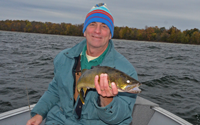
The Tim Higgins Walleye clinic, scheduled for the shoreline of Lake Winnie got off to a strong start before being interrupted by a case of Interrupit vomitus.
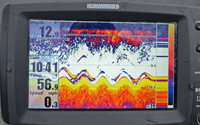
The view looking out from my office window; Walleyes on the screen of my Humminbird, it's been that way all week.
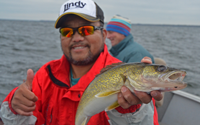
Neng " Moua" Shao shows off a nice Winnie Walleye that he caught before nap time. Yes, he did stage the much anticipated Crappie clinic, that came afterward.
|
The Surface Water Temperatures in Cutfoot Sioux were warmer than out on the big lake, 59.5 degrees was a good average and that gives us more time to work with prior to the turnover.
For me, I'm hoping that one more trip to the Walleye hole will carry me into Wednesday, which begins a period that allows more experimentation. As much I have loved being on Winnie this fall, some fresh scenery will feel good. Wherever I wind up, you know that you'll be the first to know!
 Fishing Report October 5 - Winnie's Water Cooling, Walleye Action Steady Fishing Report October 5 - Winnie's Water Cooling, Walleye Action Steady
58 Degrees was the surface temperature on Lake Winnibigoshish this Sunday. For me, this means that the calendar is catching up with us and even though the "hot bite" seems like it should last forever, it won't. Our pre-turnover days are numbered, but between then and now, we should still have some fun out there.
Some of you are thinking, Hey, wait a minute, I was out there on Sunday, I fished right next to you and I didn't find any "hot bite", Que Pasa?
Well, if you've been following the reports about Winnie for the past couple of summers, then You Know; for the past few years, anytime you find calm seas and sunny skies, it has spelled trouble for Walleye fishermen on the big lake. We've talked about the clear water and finicky Walleyes a lot already, so there's no need to go back over all of that.
Let's talk about what makes me call this a hot bite and to help illustrate, please recall something I said about Leech Lake last fall; "If you can catch some fish when the conditions are wrong, like during mid-day when the sun is shining and the seas are calm, then you can be assured that fishing will be good whenever the conditions turn favorable".
That's what I saw on Sunday; conditions we completely un-favorable, but some of the fish bit anyway. So for me, that makes this a "hot bite" and if I can get back out there before the other shoe (fall turnover) drops, then I'm gonna have a few more really good days before the turnover strikes and it becomes time to move along.
So now you might be thinking; "Tell me then Mr. Guide Man, why didn't I find the hot action, what was I doing wrong out there?"
Well, here's what I observed. After arriving at my second fishing spot and finding no other boats in the area, I looked at my graph, then turned to Mr. C and said; "we found the fish, and if I can get 'em to bite, we'll have 'em all to ourselves." That statement would turn out to be true, but not right away.
|

Red Sky At Night, Sailors Delight! |
Within a half hour, there was an assembly of about a dozen boats gathered nearby, some of you got there in time to enjoy a brief wave of action, some didn’t. But soon, everybody had something in common; impatience set in and you moved along in search of the "really hot bite".
Within an hour, the whole crowd was gone, Mr. C and I were there by ourselves again and almost as if somebody had waved their magic wand, we started getting bit. No, the fish weren't jumping in the boat, but we were enjoying a solid episode of slow, but steady action.
If you were there, but didn't share my experience and wonder why, then here's what I think went wrong. I think that you might have forgotten to trust your electronics.
Unless your boat is equipped with some sort of broken down, Ukrainian sonar rig from the 1960's, your graph should have been telling you the same thing that my Humminbird was telling me. Mine was screaming at me, it was saying; "look at all of the fish down there; if you can figure out how to make them bite, then Mr. C will be all smiles!" I trusted my graph and my patience was rewarded, it was that simple.
Kenny Rogers sang, you've got to KNOW when to hold 'em, KNOW when to ....
Whenever you see me out there next time, swing up alongside and let’s chat for a minute. Don't worry, I won't bark at you and who knows, maybe I can help figure out if it's time to hold 'em or fold 'em.
Oh and by the way, no, we did not catch our full limits of Walleye. In fact, we returned to shore with 5 of 6 keeper size Walleyes for Mr. C.
Along the way, we caught and released a dozen slot-fish and a bunch of small to medium size Pike. If we had been motivated to keep some, we would have easily been able to bag our 6 Pike.
Like I said; if you can catch some fish when conditions are wrong, just imagine how good it will be whenever they turn favorable again. Questions? >> Email
 Fishing Report October 4 - Bluegills In Transition
Fishing Report October 4 - Bluegills In Transition
After reading yesterday's report, I wonder if you wondered what I'd do with the "A Team" for day 3 of our fall trip. If you guessed that we would go fishing for Sunfish, then it’s time for you go to the head of the class!
It's been well over a month since the last time I had a chance to spend time on a mission to catch Sunnies, so I had to do some searching to find them. Luckily, once I did, the fish were cooperative; I'd say that the action was above average.
From the landing to our first fishing area, Surface Temperatures ranged between 59 and 60 degrees. This was the first time this fall that I'd seen it drop below 60 degrees and it only occurred in a small area where the wind was blowing off shore. Still, it's a signal that this fall peak period doesn't linger, soon the temperatures will drop into the cold zone and we'll be looking over our shoulders for the Fall Turnover.
Watching the Humminbird for signs of fish, there were numerous small packs of fish roaming over a flat in the 16 to 17 foot range. I waited until I spotted one pack that was larger, tossed in my marker buoy, sent the boys in after them and ... we caught Crappies. That was a nice start, but the fish were wearing the wrong colors. The next stop produced some Bluegills, this time they were too small, but there were some Crappies mixed in too. The third try is a charm right? Nope, another stop that produced Crappies but not the big Panfish that we came looking for. We were being entertained by the Crappies and that was good, but I still wanted to find some Bluegills.
In my infinite wisdom, I decided that heading to a different lake would be a good idea. So I motored across the small lake and just as I was about to leave, I stumbled across a pack of fish in 12 feet of water and guess what? We left the lake at 2:00 PM with bag limits of Bluegills for the boys and a few left over for a fish fry of my own too.
Once we knew where they were, it wasn't that hard to coax them into striking. We used #6 Lindy Ice Worms tipped with Waxies and we fished them slowly, about a foot off of the bottom.
The fish were holding around the edges of a small rock pile that topped off at 11 feet and dropped into about 15 feet of water. On this spot, the best depth was 12 to 13 feet, but there were a few outliers too, some of them were all the way down to the base of the drop off at 15 feet. This location was apparently a resting or staging area for the fish after they'd moved out of the weeds, but before they travelled into the middle of the small, shallow water lake.
This information could tell you that Panfish in your favorite lake are in transition too. They may be located somewhere between where they were this summer and where they'll be after the water gets even colder.
So if there's a takeaway from this report, it ought to be that you should always keep your eyes glued to the screen of your graph, even if you're on your way to another lake.
You never know what you’re gonna stumble in to until you stumble into it, I call it "LUCKY"!
For today, I'll be back to the Walleye fishing and enjoying this incredible run of gorgeous fall weather. I think that I’ll be heading for Winnie again.
Listen, I don't know anybody could not want to get out on the lake and share these beautiful days. But if you're on the fence, think about this; 57 days from now, right here on this very page, you will be reading Ice Fishing Reports, just a thought.
 |
Wired2Fish - Man Catches Fish With A Drone!
We've seen about every way there is to catch a fish and just saw one today that was a first for us, a fish caught on a drone. Popular YouTube personality Farmer Derek filmed himself fishing off his dock and catching a fish on his remote-controlled video drone. It's a pretty neat little video. We heard some guys on a recent outing grumbling about ... View Video >> Man Catches Fish With Drone
|
 Fishing Report October 3 - Leech Lake Walleyes, Cutfoot Crappies Fishing Report October 3 - Leech Lake Walleyes, Cutfoot Crappies
It took a little longer than expected, but Leech Lake fans should be enthused by reports that daytime Walleye action is both picking up and becoming more wide spread. Now that surface temperatures are poised to fall below the 60 degree threshold, Walleyes are getting a bit more serious about feeding.
For the past couple of weeks, it has sounded like Sucker Bay was the only game in town in terms of reliability. On Thursday, friends told me about their trip in Portage Bay; they caught 10 keeper Walleyes for 3 people. Yes, I know that's not a full bag limit, but I would definitely be proud of that catch, especially when you realize the fantastic average size of the Walleye being bagged on the giant lake.
Jig and Minnow presentations are reliable now and working the weeds continues to be the most reliable location. That is unless the wind blows, when the lake is choppy, popular fall fishing locations that feature rocks are producing well too.
Perch fishing on Leech has not kicked into high gear yet and even if it does, it’s not expected to be an outstanding fall for Jumbos. According to DNR fisheries staff, Perch numbers are down significantly this year, especially numbers of large fish. On my most recent trip to Portage Bay, fish over 10 inches were very hard to come by; in fact we didn’t bag any fish that we considered keepers.
Cutfoot Sioux provided us with an entertaining morning of Crappie fishing on Friday. Surface temperatures now range between 60 and 62 degrees depending on where you check. The cooler temperatures are encouraging more fish to move into open water and that was apparent by looking at the screen of my Humminbird.
So far, Crappies have not made the big move into wide open spaces, at least not in mass numbers. The key depths range between 20 and 26 feet and the fish are travelling in small schools.
We caught plenty of fish using a 1/8 ounce Lindy Jig tipped with small fatheads, but I did experiment with some Ice Jigs tipped with wax worms too. I was hoping to stumble into a handful of Sunfish to round out the larder for our evening fish fry. I did catch a few Sunnies, but the size was poor, all of them were smaller than 7 inches.
The #6 Ice Worm, tipped with a Wax Worm did produce some nice Crappies though and this is fast becoming one of my favorite baits for fall fishing. The heavy weight of the jig allows me to get down fast and keep a tight line The compact size of the lure allows Sunfish to easily inhale the bait, making it easy to hook them.
I’m sure that you’ve heard the term “A Team” thrown around a lot. For me, fishing with Larry and Tim represents the quintessential “A Team”. These guys don’t make too many mistakes and that means that today I’ve got some head scratching to do. Thanks to the fine treatment we’ve received from the fish, we’re headed into day 3 of our fall fishing trip with bag limits of Walleye, Pike and Crappie already packaged and frozen.
I’m not sure if we’ll try to target Sunfish today or maybe try to locate some keeper size Perch. We might pull out the heavy artillery and try to CPR some of the nice Pike that continue to inhabit the weeds on Winnie. I Know, it’s a heck of a problem to figure out; hopefully I can formulate a nice plan, whatever we do, you’ll be the first to know. |
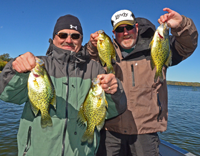
The quintessential "A Team", Tim Fischbach and Larry Lashley have presented me with a dilemma; what will we fish for next?

Crappies remain shallow, following soft shoreline breaks in water depths of 20 to 26 feet.
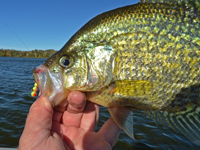
The weight of Lindy's #6 Ice Worm allows me to get down to the fish fast and helps me keep a tight line.
|
 Fishing Report October 1 - Winnie and Cutfoot, Most Reliable Bite In Town Fishing Report October 1 - Winnie and Cutfoot, Most Reliable Bite In Town
One of the most gratifying things that anybody has said to me during the entire 2015 fishing season was; "You were right." Of course anybody would love to hear those words coming from a good friend, no matter what the circumstances. But in this particular case, it meant more.
What he meant was that I made an accurate prediction last spring when I shared these words; "Just give the old girl (Winnie) a chance, once the fish have time to catch up eating some of the surplus baitfish and system gets back into balance, this lake is gonna offer the best action around."
That conversation came during a time when Lake Winnibigoshish was getting a lot of bad press from "the gloom and doom crowd". Standing on the mountain top, they made proclamations that Winnie had every problem in the book. Some of their reasoning seemed justified, some of it was just plain silly, but almost none of it was ever based on any hard evidence.
I'm sure that there were times that I sounded like a cheerleader for the losing team, but I held my ground and guess what?
Lake Winnibigoshish may not be quite all of the way back at the top of her game just yet, but Winnibigoshish IS providing anglers with some of the best action in the Itasca area right now. And that's especially true for folks who want to catch a variety of fish, all on one trip, and all on one presentation.
On Tuesday, we found surface water temperatures on the big lake holding steady at 62.5 degrees. A south wind was strong enough to produce some whitecaps, but not strong enough to stir up the bottom. Whatever Algae bloom there was before has almost completely cleared up. It was easy to see the bottom in water depths of 8 to 10 feet, even with the choppy surface water.
Cabbage weeds, Canada Waterweed and some other hearty submerged plants remain healthy, but many of the more fragile shallow water weeds are gone. The lack of weed cover combined with the gin clear water means that most fish have moved away from shallow areas that do not provide weed cover.
The best cover available is the Weeds growing along the breaklines in the 12 to 14 foot depth range. There are good beds of these deep weeds in Tamarack Bay, Third River, and on the north, south and west shorelines. Weeds that were growing along the east side of the lake are getting harder to find all of the time, they may not be completely gone, but what's left is sparse.
Almost every patch of good cover that we found provided some sort of opportunity. We caught Walleye, Pike and Perch in random order and if I saw fish on my screen, they bit. In fact, there was one instance where we actually watched a Walleye on my Humminbird as it got caught during my announcement to the crew that I could see it under the boat, which was fun.
For most of the summer, folks have been fishing these weed lines using Little Joe Spinners tipped with minnows or night crawlers. With water temperatures cooling, jig and minnow presentations are becoming more reliable every day. On Wednesday, we used 1/8 ounce Lindy Jigs tipped with large fatheads, lake shiners or Rainbows. All of the minnow types produced good results, but no matter what type of minnow we used, the largest size minnows produced the best results.
Recently, catching fish from the 2013 year class, in the 14 to 15 inch size range has been fairly easy. On this particular trip, a good share of the Walleye we caught fell within the protected slot. That was unusual when compared to recent trips and it probably means that we're seeing a migration of fish arriving from the middle of the lake.
More about Winnie tomorrow, if you're on your already on your way, well Good Luck then !! |

With cooler temperatures comes the onset of Northern Minnesota's Fall Color Season. Colors this weekend should be fantastic.
|
Do You Know that you can even post your own helpful hints to our fishing reports page on facebook? YES! You Can! You don't have to tell us your secrets, just go ahead and brag a little when you get a whopper! Click >>>
Fishing Reports Minnesota .
YouTube
| And ... did you know that Jeff's Thursday Morning Program is available for two weeks after the air date? Yes, you'll never need to miss the show. Click the image and then select the 6:00 hour on Thursday. Scroll in to about 6:20 AM and you're in business! |
 |

![]() (10/18) Q&A I had a crappie question for you. From June up until early October, I've been doing well with the crappies with a 1/16 oz. Little Nipper and 1 inch Gulp minnow, but that bite has shut down in the last week. Do crappies switch from Gulp back to live minnows once the water gets cooler? I'm thinking I need to switch to live bait and slip bobbers and slow it down. This worked well in the spring. Any thoughts you have would be great!
(10/18) Q&A I had a crappie question for you. From June up until early October, I've been doing well with the crappies with a 1/16 oz. Little Nipper and 1 inch Gulp minnow, but that bite has shut down in the last week. Do crappies switch from Gulp back to live minnows once the water gets cooler? I'm thinking I need to switch to live bait and slip bobbers and slow it down. This worked well in the spring. Any thoughts you have would be great! 
![]() Fishing Report October 4 - Bluegills In Transition
Fishing Report October 4 - Bluegills In Transition






























